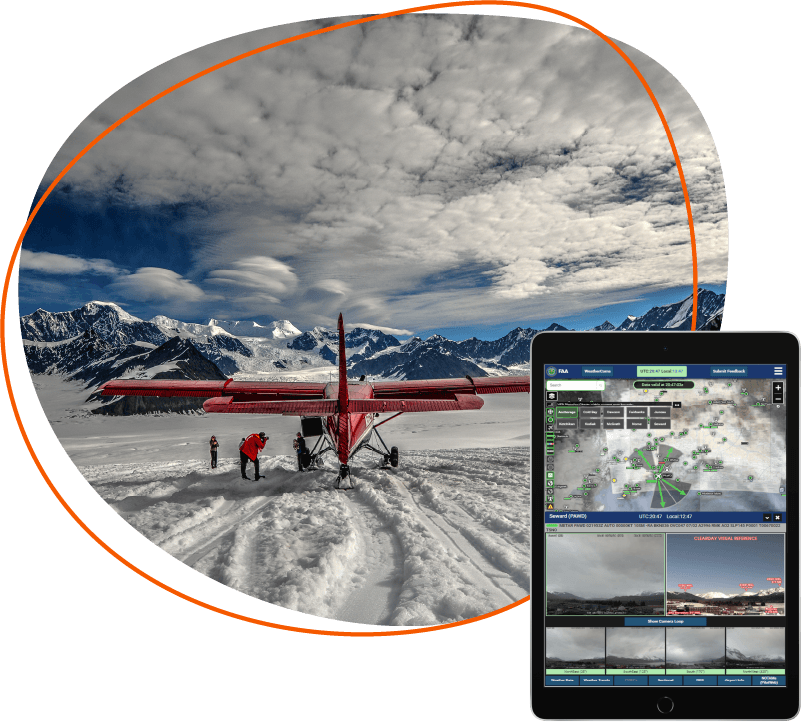
In Brief
A powerful web tool improves aviation safety and reduces costs
Pilots in Alaska often fly in remote locations and in severe weather patterns, facing higher risks of accidents and flight interruptions. To improve aviation safety, the Federal Aviation Administration (FAA) initiated a successful weather camera program in 1999 which gave pilots access to weather data and live-camera feeds.
Two decades later, they partnered with Resource Data to build the next generation of their weather camera website. The new site, weathercams.faa.gov, is a progressive web app that makes a wealth of complex information quickly accessible to pilots before and during flights. It receives over 230 million hits per year by pilots who rely on it to make safe aviation decisions.
Key Takeaways
Timely, accurate weather information saves lives and cuts costs in the world of aviation
-
Complete flight solution for holistic view
With access to more data than before, the new FAA WeatherCams site equips pilots with a holistic view that includes advisory weather reports, aeronautical charts, and more.
-
Near real-time imagery for better preflight planning
The camera images provide multiple views at each location and update every 10 minutes. This means pilots assess routes before flying based on accurate information to avoid potential hazards and unnecessary operational costs.
-
Cloud technology for load balancing
FAA WeatherCams was built using the latest cloud technologies, making the website fast and scalable to accommodate thousands of simultaneous users.
-
Pilot-centric design for information at a glance
FAA subject matter experts, pilots, and human factor experts guided the user interface design, ensuring data, terminology, and symbology are familiar to pilots.
-
Real aviation safety results support rapid expansion
Over a seven year period, FAA saw a 69% reduction in weather-related flight interruptions and 85% reduction in weather-related aviation accidents. Following Alaska’s success, the FAA has rapidly extended the program and now uses more than 600 camera sites throughout North America.

The Challenges
Website integral to aviation safety in need of modernization
Alaska spans 586,412 sq. miles with 33,904 miles of coastal land. With 82% of communities lacking road connections, planes are a vital form of transportation. It is critical for pilots to be able to access accurate weather information and imagery across the state, especially in remote areas where there are no routine weather-reporting facilities or systems. The FAA began its weather camera program in Alaska in 1999 to provide supplementary information to pilots.
Camera services proved so successful at reducing weather-related aviation accidents the system quickly grew to more than 230 camera sites; many were in remote locations such as mountain passes where weather can create a chokepoint and coastal areas where fog routinely interferes with Visual Flight Rules (flying based on visual observation of the terrain).
Over time, the FAA recognized the need to enhance the weather camera program’s effectiveness and ease of use for pilots. Their goal was to provide more data while ensuring optimal site performance across various devices. To achieve this, the legacy website needed to be rebuilt leveraging modern technologies.
Our Approach
A pilot-centric approach built on collaboration
Resource Data worked closely with FAA subject matter experts and pilots for several years to design the interactive WeatherCams website specifically for pilots. An agile approach allowed us to closely collaborate with a human factors’ expert from the FAA. They provided expertise regarding how pilots interact with cockpit systems and pre-flight planning data.
This expertise combined with live testing by Alaska pilots, helped guide the user-interface design and ensured the data, terminology, and symbology was the most effective and efficient way to present crucial information to pilots.

Solution
Robust preflight planning tool allows pilots to “Look Before they Fly”
The new website is now a comprehensive system with enhanced weather data and an improved user interface that conveys conditions more effectively at a glance. The Progressive Web App (PWA) uses React and other modern front-end frameworks that load large amounts of data quickly and work well on mobile and desktop devices. The backend is a Node.js-driven platform that aggregates data from many other sources and provides it through a REST-ful API.
We also implemented a cloud-native architecture, using serverless platforms, micro-services, cloud SQL, Docker containers, and Terraform to create a platform that is fast, reliable, scalable, and easy to deploy. The upgraded system takes advantage of modern cloud-based technologies, which positioned the FAA to expand the system beyond Alaska in support of aviation safety throughout North America.
Features
Providing pilots with critical data in a user-friendly and powerful web app
-
Interactive map and advanced search for quick access to data
Clickable weather camera icons and advanced search features allow users to easily find weather camera locations and view images for easier route planning.
-
Saved routes for future reference
Pilots sketch prospective flight paths directly on the map then view all pertinent weather information along their chosen route. Routes are saved for future use, allowing quick and comprehensive evaluation of flight plans.
-
Camera loops for identifying trends
Cameras show current sky condition and visibility using reference features. The camera loop lets users see the past six hours of images to spot trends and check if the current weather matches forecasts.
-
Toggled information layers for easy info consumption
Toggled information layers display key information at high zoom levels and more details when the user zooms in. This intuitive user experience combined with a decluttered map make inflight weather monitoring easy.



“Our mission is to improve aviation safety and efficiency within the NAS [National Airspace System] and reduce weather-related accidents and flight interruptions. We do that by getting a near real-time picture of the weather into the pilot’s hands prior to flying.”
- Cohl Pope, FAA Weather Camera Program Manager
Results
Changing the nature of flight planning and decision making
The new weather camera site, weathercams.faa.gov, provides the exact data pilots need, using a display and terminology familiar to them, to make informed route planning and go, no-go decisions. Everything from symbol placement to the colors used, makes complex information quickly accessible and understandable before and during flights.
It plays a critical role in in preflight planning and inflight monitoring of weather at airports and en route locations. The website receives over 230 million hits per year and continues to yield amazing results, reducing weather-related flight interruption hours and aviation accidents.
“The weather cameras have been a game changer in Alaska.”
- Eric Albrecht, Operations Support Manager for Alaska Flight Services

What's Next
Building a nationwide network of weather cameras
Following the success of Alaska’s WeatherCams program, the FAA expanded the program from 230 camera sites in Alaska to 600 throughout North America. They have plans to add 160 new camera sites through fiscal year 2030. The new site was built to scale to support these plans.
Resource Data continues to work closely with the FAA as they expand the WeatherCams program. New feature development continues to provide pilots with more weather data, delivered in near real-time; enhance data quality; and accomodate more camera sites and more users.




